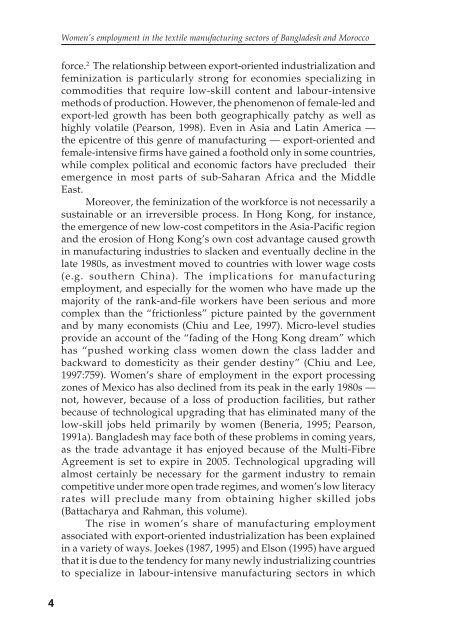Women's Employment - United Nations Research Institute for Social ...
Women's Employment - United Nations Research Institute for Social ...
Women's Employment - United Nations Research Institute for Social ...
Create successful ePaper yourself
Turn your PDF publications into a flip-book with our unique Google optimized e-Paper software.
Women’s employment in the textile manufacturing sectors of Bangladesh and Morocco<br />
<strong>for</strong>ce. 2 The relationship between export-oriented industrialization and<br />
feminization is particularly strong <strong>for</strong> economies specializing in<br />
commodities that require low-skill content and labour-intensive<br />
methods of production. However, the phenomenon of female-led and<br />
export-led growth has been both geographically patchy as well as<br />
highly volatile (Pearson, 1998). Even in Asia and Latin America —<br />
the epicentre of this genre of manufacturing — export-oriented and<br />
female-intensive firms have gained a foothold only in some countries,<br />
while complex political and economic factors have precluded their<br />
emergence in most parts of sub-Saharan Africa and the Middle<br />
East.<br />
Moreover, the feminization of the work<strong>for</strong>ce is not necessarily a<br />
sustainable or an irreversible process. In Hong Kong, <strong>for</strong> instance,<br />
the emergence of new low-cost competitors in the Asia-Pacific region<br />
and the erosion of Hong Kong’s own cost advantage caused growth<br />
in manufacturing industries to slacken and eventually decline in the<br />
late 1980s, as investment moved to countries with lower wage costs<br />
(e.g. southern China). The implications <strong>for</strong> manufacturing<br />
employment, and especially <strong>for</strong> the women who have made up the<br />
majority of the rank-and-file workers have been serious and more<br />
complex than the “frictionless” picture painted by the government<br />
and by many economists (Chiu and Lee, 1997). Micro-level studies<br />
provide an account of the “fading of the Hong Kong dream” which<br />
has “pushed working class women down the class ladder and<br />
backward to domesticity as their gender destiny” (Chiu and Lee,<br />
1997:759). Women’s share of employment in the export processing<br />
zones of Mexico has also declined from its peak in the early 1980s —<br />
not, however, because of a loss of production facilities, but rather<br />
because of technological upgrading that has eliminated many of the<br />
low-skill jobs held primarily by women (Beneria, 1995; Pearson,<br />
1991a). Bangladesh may face both of these problems in coming years,<br />
as the trade advantage it has enjoyed because of the Multi-Fibre<br />
Agreement is set to expire in 2005. Technological upgrading will<br />
almost certainly be necessary <strong>for</strong> the garment industry to remain<br />
competitive under more open trade regimes, and women’s low literacy<br />
rates will preclude many from obtaining higher skilled jobs<br />
(Battacharya and Rahman, this volume).<br />
The rise in women’s share of manufacturing employment<br />
associated with export-oriented industrialization has been explained<br />
in a variety of ways. Joekes (1987, 1995) and Elson (1995) have argued<br />
that it is due to the tendency <strong>for</strong> many newly industrializing countries<br />
to specialize in labour-intensive manufacturing sectors in which<br />
4
















